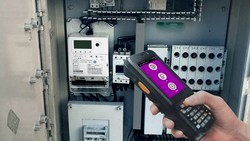As the power sector embraces more renewable resources such as solar and wind, utilities are encountering challenges in efficiently transporting this clean energy to where it is needed most. Congested transmission lines and outdated infrastructure can hinder further adoption of renewables and increase costs. Therefore, addressing power grid bottlenecks is crucial to enable a large-scale transition to clean energy.

(symbol image, credit CLOU)
The Challenge of Intermittent Resources
Unlike traditional coal and gas plants that consistently generate power, renewables are subject to fluctuations based on weather conditions. This variability strains ageing transmission lines that were designed for one-way electricity flows. As renewable penetration increases in bottlenecked regions, curtailment becomes a growing concern, undermining both the economic and environmental benefits of clean energy.
Solutions for a Modernized Grid
To optimize grid utilization, utilities, regulators, and lawmakers are pursuing a range of technical and market-based solutions:
Transmission Line Upgrades
Strategic reinforcement and the establishment of new high-voltage paths are essential for facilitating the transport of renewable energy over long distances while minimizing line losses.
To address power grid bottlenecks, utilities are investing in the enhancement and strengthening of existing transmission lines. This involves conducting thorough assessments to identify areas where the grid is most constrained and where upgrades are most urgently needed. By strategically reinforcing these transmission lines, utilities can improve their capacity to handle the increasing volume of renewable energy.
Additionally, the establishment of new high-voltage paths is crucial for efficiently transmitting renewable energy across vast distances. These paths, often referred to as "green corridors," are designed to connect renewable energy generation centers with high-demand regions. By creating dedicated channels for renewable energy transmission, utilities can alleviate congestion on existing transmission lines and ensure a smooth flow of clean energy to areas where it's needed most.
These transmission line upgrades not only enhance the reliability and efficiency of the grid but also enable utilities to tap into remote renewable resources that might otherwise be stranded. By unlocking access to these untapped resources, utilities can maximize the utilization of renewable energy and optimize the overall performance of the grid.
Furthermore, these upgrades play a vital role in integrating intermittent renewable energy sources into the grid. As solar and wind power generation fluctuates with weather conditions, the transmission lines must be able to handle these variations and balance the intermittent supply. Upgraded transmission lines with enhanced capacity and improved stability make it easier for grid operators to manage the influx of renewable energy, reducing curtailment and ensuring a reliable power supply.
Energy Storage
The implementation of distributed batteries, pumped hydro, and other storage technologies, including CLOU's cutting-edge energy storage solutions, enables the shifting of intermittent renewable power to peak demand periods, alleviating congestion on the grid.
As the penetration of renewable energy sources continues to grow, the need for effective energy storage solutions becomes increasingly important. Energy storage technologies play a pivotal role in balancing the intermittent nature of renewable power generation and ensuring a reliable and stable electricity supply.
One of the key benefits of energy storage is the ability to store excess renewable energy during times of high generation and release it when demand peaks. This is particularly crucial as renewable energy sources, such as solar and wind, are subject to fluctuations due to weather conditions. By capturing this excess energy and storing it in distributed batteries, pumped hydro facilities, or other storage technologies, utilities can then dispatch it during periods of high demand, reducing strain on the grid.
CLOU's innovative energy storage solutions, such as our advanced battery storage systems, offer a reliable and efficient means of storing renewable energy. These cutting-edge systems are designed to seamlessly integrate with renewable power sources, capturing surplus energy and providing a flexible and controllable energy supply when needed most. With CLOU's energy storage solutions, utilities can optimize the utilization of renewable energy, reduce curtailment, and enhance grid stability.
In addition to addressing intermittent power supply, energy storage technologies also provide ancillary services to the grid. They can offer frequency regulation, voltage support, and grid stabilization, ensuring a smooth and reliable flow of electricity. By utilizing CLOU's energy storage solutions, utilities can enhance the overall resilience and efficiency of their grid infrastructure.
Furthermore, distributed batteries and other energy storage technologies offer the potential for localized energy resilience. In areas prone to outages or with limited grid connectivity, these storage systems can provide backup power, enhancing grid reliability and empowering communities to become more self-sufficient.
Demand Response
Dynamic pricing programs, coupled with the implementation of smart meters and advanced metering infrastructure (AMI) solutions like the ones offered by CLOU, incentivize consumers to shift flexible loads, such as electric vehicle charging, to off-peak times. This proactive approach helps offset supply variability, reduces strain on the grid during peak hours, and promotes a more efficient and sustainable energy consumption pattern.
As the demand for electricity continues to rise, grid operators face the challenge of balancing the supply and demand dynamics in real-time. Demand response programs offer an effective solution by engaging consumers in actively managing their energy consumption. By utilizing dynamic pricing, consumers are encouraged to adjust their electricity usage based on the current grid conditions and pricing signals.
Smart meters, a critical component of AMI solutions, enable real-time monitoring and communication between consumers and utilities. These meters provide accurate and detailed information on energy consumption patterns, allowing consumers to make informed decisions about their usage. With CLOU's advanced smart meters, utilities can gather granular data on energy consumption, enabling them to develop tailored pricing plans and implement demand response initiatives.
Dynamic pricing programs, supported by smart meters and AMI solutions, introduce time-of-use (TOU) rates that vary throughout the day. During peak hours when electricity demand is high, the prices are higher, while off-peak hours offer lower rates. By shifting flexible loads, such as electric vehicle charging or certain appliances, to off-peak times, consumers can take advantage of the lower rates, reducing their energy costs and contributing to overall grid stability.
CLOU's AMI solution plays a crucial role in facilitating demand response programs. With our advanced metering infrastructure, utilities can remotely monitor and manage energy consumption, enabling seamless integration of dynamic pricing and demand response initiatives. Through real-time data exchange between smart meters and utility systems, consumers can receive timely information about pricing signals, allowing them to make informed decisions about their energy usage.
Furthermore, demand response programs promote energy efficiency and sustainability. By encouraging consumers to shift their energy consumption to off-peak times, demand during peak hours is reduced, alleviating strain on the grid and minimizing the need for additional fossil fuel-based power generation. This not only helps offset supply variability but also contributes to reducing greenhouse gas emissions and promoting a cleaner energy future.
Distributed Generation
The utilization of localized resources, such as rooftop solar, plays a significant role in meeting local energy demand while alleviating the strain on long transmission lines. This approach to generating electricity not only reduces congestion pressures on the grid but also promotes a more sustainable and resilient energy system.
Traditionally, electricity generation has been centralized, with large power plants located far away from the end consumers. This necessitates the transmission of electricity over long distances through extensive networks of transmission lines. However, this centralized model poses challenges such as transmission losses, grid congestion, and vulnerability to disruptions.
The adoption of distributed generation technologies, like rooftop solar panels, enables the production of electricity closer to where it is consumed. By harnessing the power of the sun, households, businesses, and communities can generate their own electricity, reducing their reliance on the centralized grid. This localized approach offers several advantages.
Distributed generation reduces the strain on long transmission lines. When electricity is generated closer to the point of consumption, there is less need to transmit it over extensive distances. This reduces the congestion pressures on the grid, alleviating the burden on the transmission infrastructure and enhancing its overall efficiency.
Moreover, distributed generation enhances grid resilience. In the event of a disruption in the centralized grid, such as a power outage or natural disaster, localized resources like rooftop solar panels can continue to generate electricity, providing a reliable source of power for critical loads. This decentralized approach ensures that essential services can function even during grid disturbances, enhancing the overall resilience of the energy system.
Additionally, distributed generation promotes a more sustainable energy future. By harnessing renewable energy sources like solar power, communities can reduce their carbon footprint and contribute to mitigating climate change. Rooftop solar installations not only generate clean electricity but also reduce the need for energy to be generated from fossil fuel-based power plants. This transition to cleaner energy sources is crucial in addressing environmental concerns and moving towards a low-carbon economy.
Furthermore, distributed generation empowers consumers by giving them greater control over their energy production and consumption. With rooftop solar panels, individuals and businesses can generate their own electricity and even sell the excess back to the grid. This not only reduces their energy bills but also fosters a sense of energy independence and self-sufficiency.
Advanced Forecasting
In the dynamic landscape of the modern energy grid, accurate forecasting of generation and load patterns has become increasingly crucial. With the help of improved forecasting tools, grid operators can gain valuable insights into the variable inflows and outflows of renewable energy sources. This enables proactive management of bottlenecks and ensures efficient grid operations.
As renewable energy sources, such as solar and wind, become more prevalent in the energy mix, their inherent variability poses unique challenges for grid operators. Unlike traditional power plants, renewable energy generation is subject to fluctuations due to weather conditions and other factors. This variability can lead to imbalances between generation and demand, potentially causing grid instability and reliability issues.
To address these challenges, advanced forecasting tools have emerged as valuable assets for grid operators. These tools utilize sophisticated algorithms and models to analyze historical data, weather patterns, and other relevant factors to predict future generation and load patterns with greater accuracy.
By accurately forecasting the inflows and outflows of variable renewable energy sources, grid operators can better anticipate the supply-demand dynamics and manage potential bottlenecks. This allows for proactive decision-making in optimizing grid operations, such as scheduling maintenance activities, adjusting generation sources, and coordinating energy exchanges between regions.
One of the key benefits of advanced forecasting is its ability to enable the integration of higher levels of renewable energy into the grid. By having a more accurate understanding of when and where renewable energy generation will occur, grid operators can plan and allocate resources more efficiently. This helps to minimize the need for curtailment and maximize the utilization of renewable energy sources, leading to a more sustainable and cost-effective energy system.
Furthermore, advanced forecasting plays a vital role in grid stability and reliability. By having reliable predictions of renewable energy inflows, grid operators can better balance the supply and demand, ensuring that the grid operates within its operational limits. This helps to prevent grid congestion, voltage fluctuations, and other issues that can compromise the reliability of the electricity supply.
Advanced forecasting also enables grid operators to optimize their use of conventional energy sources. By accurately predicting renewable energy generation, the need for ramping up or down conventional power plants can be better coordinated, reducing the reliance on fossil fuel-based generation and minimizing greenhouse gas emissions.
Market Reforms
As the energy landscape continues to evolve, market reforms play a significant role in optimizing the usage of renewable energy sources despite infrastructure constraints. By implementing changes such as the participation of storage and demand response in wholesale markets, the establishment of region-wide capacity markets, and coordinated planning across utility service areas, the energy sector can unlock the full potential of renewables while ensuring efficient and reliable grid operations.
One key aspect of market reforms is the integration of energy storage systems and demand response mechanisms into wholesale markets. Energy storage technologies, such as batteries, pumped hydro storage, and thermal storage, provide the ability to store excess renewable energy during times of low demand and release it during times of high demand. By allowing these storage systems to participate in wholesale markets, grid operators can better manage the intermittent nature of renewable energy generation and balance the supply and demand fluctuations. This not only enhances grid stability but also maximizes the utilization of renewable energy resources.
In addition to energy storage, demand response programs also play a crucial role in market reforms. Demand response enables consumers to adjust their electricity usage in response to grid conditions or price signals. By incentivizing consumers to reduce their electricity consumption during peak demand periods or when renewable energy supply is limited, grid operators can effectively manage the demand-supply balance and alleviate stress on the grid infrastructure. This helps to avoid grid congestion, minimize the need for additional generation capacity, and optimize the usage of renewable energy sources.
The establishment of region-wide capacity markets is another important aspect of market reforms. Capacity markets provide incentives for resource adequacy, ensuring that there is sufficient generation capacity available to meet the electricity demand. By extending these markets across utility service areas, grid operators can facilitate the efficient deployment of renewable energy resources. This allows for better coordination of generation capacity planning, reducing the reliance on fossil fuel-based generation and promoting the integration of renewable energy sources.
Coordinated planning across utility service areas is also vital in optimizing the usage of renewables despite infrastructure constraints. By taking a holistic approach to grid planning and development, grid operators can identify areas of high renewable energy potential and strategically allocate resources to support their integration. This includes upgrading and expanding transmission infrastructure, implementing grid modernization technologies, and collaborating with stakeholders to overcome regulatory and operational challenges. Coordinated planning ensures that renewable energy resources are effectively harnessed and transmitted to areas with high electricity demand, maximizing their contribution to the overall energy mix.
By combining these innovative solutions, grid planners and managers aim to maximize the potential of the existing system while facilitating an accelerated transition to a cleaner, more efficient, and resilient grid of the future. Overcoming power grid bottlenecks is essential to achieve this vision.
By combining these innovative solutions, grid planners and managers aim to maximize the potential of the existing system while facilitating an accelerated transition to a cleaner, more efficient, and resilient grid of the future. Overcoming power grid bottlenecks is essential to achieve this vision.
Takeaway
Addressing power grid bottlenecks is crucial for the successful integration of renewable energy into the existing power infrastructure. By implementing transmission line upgrades, energy storage solutions, demand response programs, distributed generation, advanced forecasting tools, and market reforms, we can pave the way for a clean energy future.
If you have any inquiries or need further information about how CLOU can contribute to overcome power grid bottlenecks, please do not hesitate to reach out to us. We are here to assist you and welcome your valuable thoughts and comments.
Until then, keep those electrons flowing smoothly and stay powered up!





All comments are moderated before being published. Inappropriate or off-topic comments may not be approved.